|
US Navy`s family of DSV-Deep Submergence Vehicles
Alvin (DSV-2)-laid down by General Mills; commissioned June 5, 1964
Turtle (DSV-3)- laid down by Electric Boat Co.; commissioned June 1st, 1970
Sea Cliff (DSV-4)- laid down by Electric Boat Co.; commissioned June 1st, 1970
 The Navy`s Submarine Development Squadron 5 (formerly Submarine Development Group 1) operates several Deep Submergence Vehicles capable of deep ocean floor salvage work, and retrieval and emplacement of material of interest to the intelligence community. These vessels are all part of the single DSV class, although there are substantial differences in configuration between individual submersibles. The Navy`s Submarine Development Squadron 5 (formerly Submarine Development Group 1) operates several Deep Submergence Vehicles capable of deep ocean floor salvage work, and retrieval and emplacement of material of interest to the intelligence community. These vessels are all part of the single DSV class, although there are substantial differences in configuration between individual submersibles. Although there had been attempts since antiquity to work underwater, humans had never been able to penetrate very far into the depths until the 1930s, when William Beebe, an American ichthyologist, succeeded in reaching a depth of 1,000m in his "bathysphere" ("bathy" = deep).
The bathyscaphe ("bathy" = deep, "scaphe" = ship) Trieste was built in 1953 at Naples, Italy, by the Swiss scientist Auguste Piccard. The Trieste, essentially a steel sphere attached to large float filled with aviation petrol for buoyancy, lacked manipulators or samplers, and it was quite large and not very maneuverable. In October 1959, after being fitted with a stronger pressure sphere, Trieste was transported to the mid-Pacific to participate in Project "Nekton", in which she conducted a series of very deep dives in the Marianas Trench. On January 27, 1960 the Triestetook two men to a depth of 35,800ft (10,910m), the deepest spot in the ocean, in the Mariana Trench near Guam. The bathyscaphe was retired soon after that, and some of her components were used in the newly constructed Trieste II.
 When US submarineThresher was lost, a committee established under Admiral Stephan, the oceanographer of the Navy, to assess the implications of the accident concluded that the Navy did not have the operational assets to conduct missions in the deep sea. To rectify this deficiency the Deep Submergence Systems Project was established to develop deep ocean capabilities. Subsequently other associated development programs were assigned to the Deep Submergence Systems Project office, including the development of the NR-1 nuclear powered research submarine. The intelligence community also established Deep Submergence development requirements. When US submarineThresher was lost, a committee established under Admiral Stephan, the oceanographer of the Navy, to assess the implications of the accident concluded that the Navy did not have the operational assets to conduct missions in the deep sea. To rectify this deficiency the Deep Submergence Systems Project was established to develop deep ocean capabilities. Subsequently other associated development programs were assigned to the Deep Submergence Systems Project office, including the development of the NR-1 nuclear powered research submarine. The intelligence community also established Deep Submergence development requirements.
A decision was made to build a second bathyscaphe, Trieste II, with the original Triesteassigned to the Deep Submergence Systems Project to test equipment that would be employed on other deep submergence systems. The new Trieste II, built at the Mare Island Naval Shipyard in September 1965, was a more sophisticated craft capable of clandestine operations in the deep ocean. When the USS Scorpion was lost, the previously unacknowledged Trieste II was used by the Navy to carry out the investigation. In June 1971 Trieste II was designated Deep Submergence Vehicle (DSV-1).
The subsequent development of occupied research submersibles focused on systems allowing access to undersea depths of up to 6,000m (20,000ft). The ambient pressure at these depths is over 600atm (4 tons per square inch). Most submersibles have much shallower diving capabilities (300m to 3,000m). Of the vehicles in the Navy inventory (or operated by academic contractors for the Navy), the nuclear-powered NR-1 is rated at only 1,000m (3,000ft), and the DSRVs (Deep Submergence Rescue Vehicles) Mystic (DSRV-1) and Avalon (DSRV-2) are rated to only 1,500m (5,000ft).
In 1962 the Office of Naval Research (ONR) and Woods Hole Oceanographic Institution (WHOI) began work on a more maneuverable submersible capable of operating at depths greater than 6,000ft. Three 6-foot diameter HY-100 steel spheres were fabricated, and on June 5, 1964 the DSV-2 Alvin was commissioned. The sub proved its worth in 1966 by assisting in the search for and recovery of a US hydrogen bomb accidentally lost in 780m of water off the coast of Spain. The three-place submersible Alvin, operated by Woods Hole Oceanographic Institution (in Massachusetts) for the Office of Naval Research, has four viewing ports, video and still cameras, one six function and one seven function manipulator, scanning sonar, and can be fitted with a variety of other specialized equipment. Since 1971 Alvin has been "loaned" by the Navy to Woods Hole. During a 1972-1973 overhaul, a new titanium personnel sphere was installed in Alvin to double the sub`s depth capability to 3,658m (12,000ft). Maximum operating depth was 4,000m (13,100ft), but after a prolonged effort, in 1994 the US Navy approved an increase of Alvin`s operating depth to 4,500 meters. This depth increase results in about 25% more of the ocean floor within reach of Alvin, about 86% of the ocean basins. By 1994, the 30th year of operation, none of the original Alvinremained in use, since every component of the original vehicle had been replaced over the years, including the frame and pressure hull.
 The other two spheres originally fabricated for the Alvin were later used for the Navy`s Turtle (DSV-3) and her sister ship Sea Cliff (DSV-4), built to a design similar to the Alvin. Turtle has video and still cameras, two six-function hydraulic manipulators, and four large view ports. Sea Cliff has two 7-function hydraulically operated manipulator arms, three 11-cm view ports, and video and still camera systems. While the Turtle is rated at 10,000ft operating depth, Sea Cliff had her original HY-100 steel crew sphere replaced in 1983 with a titanium sphere capable of 20,000ft operations. Sea Cliff reached this depth for the first time in March 1985, during a dive in the Middle America Trench off the Pacific coast of Central America. This increase of 1,500 meters over Alvin`s limits provides access to 37% more of the sea floor. The other two spheres originally fabricated for the Alvin were later used for the Navy`s Turtle (DSV-3) and her sister ship Sea Cliff (DSV-4), built to a design similar to the Alvin. Turtle has video and still cameras, two six-function hydraulic manipulators, and four large view ports. Sea Cliff has two 7-function hydraulically operated manipulator arms, three 11-cm view ports, and video and still camera systems. While the Turtle is rated at 10,000ft operating depth, Sea Cliff had her original HY-100 steel crew sphere replaced in 1983 with a titanium sphere capable of 20,000ft operations. Sea Cliff reached this depth for the first time in March 1985, during a dive in the Middle America Trench off the Pacific coast of Central America. This increase of 1,500 meters over Alvin`s limits provides access to 37% more of the sea floor.
All three of these DSVs are constructed of a fiberglass hull over the metal crew sphere, batteries and electric motors. The craft have television and still cameras, external lights, short-range sonars, and hydraulic remote-control manipulators. Alvin weighs 16 tons, Turtle weighs 21 tons, Sea Cliff weighs 29 tons. These DSVs have an endurance of 8 hours at 1 knot, or 1 hour at 2.5 knots. Due to their limited range and endurance, their mother ship should be certain to remain in the vicinity.
Since the end of the Cold War the submersibles Sea Cliff and Turtle and ROV ATV have been available for limited academic research through a cooperative arrangement between NOAA and the US Navy`s Submarine Development Squadron Five in San Diego CA. These vehicles have expanded opportunities for peer-reviewed deep submergence research off the US west coast. Sea Cliff and ATV have provided the science community with some additional access to the deep sea and permitted observations to depths approaching 6,000 meters, a depth range otherwise only available by using ROVJason or the other tethered vehicles of the National Deep Submergence Facility. This increase of 1,500 meters over Alvin`s limits provides access to 37% more of the sea floor, which represents an area that is greater than 90% of the surface area presently exposed on the continents.
Following the Navy`s decision to decommission Sea Cliff, NAVSEA requested Woods Hole Oceanographic Institution (WHOI) to provide a technical assessment and costing of how to best integrate Sea Cliff into the National Deep Submergence Facility. Perhaps the most serious and biggest impediment to integrating Sea Cliff into the US deep submergence program is the lack of an adequate and stable funding base.
With the advent of remotely operated and autonomous vehicles over the last decade, the crewed submersible`s utility has declined, and Turtle and Sea Cliff have been retired. According to the Naval Vessel Register, the somewhat puzzling "DSV-5" remains in service, but the fact of the existence of this vehicle is not widely attested and details remain entirely obscure.
The missing H-bomb
This is no ordinary case of lost and found. A US B-52 bomber, carrying nuclear weapons, collides with a KC-135 refueling plane over Almeria, Spain, on January 17, 1966. Eight of 14 crew members die, and an H-bomb dislodges from the bomber and falls into the Mediterranean Sea, panicking Spaniards who fear a radiation leak. The Navy`s job is to locate and recover the bomb. "We`re not looking for a needle in a haystack," says a Navy spokesman. "This is looking for the eye of the needle in a haystack." For weeks, the Navy`s underwater probes find nothing, except for such items as ancient cannonballs and a piece of the B-52`s wing. Finally, on April 7, the missing H-bomb is hauled aboard the submarine rescue ship Petrel after being located at a depth of 2,500 feet, five miles offshore, by an experimental midget submarine called Alvin, on its very first assignment. The minisub finds the 21-foot, 13-ton bomb still entangled in a parachute. And except for a few nicks, it is intact.
The CURV-Cable controlled Underwater Rescue Vehicul, is an unmanned submersible that was used for salvage operations and for recovering torpedoes and missiles from the bottom of the ocean. It was a cable controlled device and isn`t too far removed from the ROVs used today for all sorts of undersea explorations. When the bombs went down the CURV should have been the obvious choice for salvage operations. Instead the area was devoted to a number of manned submersibles (Alvin, Aluminaut, Perry Cubmarine) and the CURV was restricted from entering the search area for approximately 1 month (they were told, essentially, to practice so they spent the time dropping a cylinder overboard and recovering it). The story was that a manned recovery would make good PR towards future funding of manned submersibles. In short, the recovery was to be made by a manned submersible. However, after the bomb was located, the Alvin didn`t have the ability to grasp it and was possibly causing the bomb to slip into deeper water. The CURV finally got it`s chance to go in.
General specifications:
|
Displacement (tons)
|
Sea Cliff (DSV-4)-30
|
|
Length (feet/meter)
|
Alvin (DSV-2)-23/7.00
Turtle (DSV-3)-26/7.95
Sea Cliff (DSV-4)- 26/7.95
|
|
Beam (feet/meter)
|
8`6/2.60
|
|
Draft (feet/meter)
|
7`6/2.30
|
|
Speed (knots)
|
1 - 2.5
|
|
Depth (feet/meter)
|
Alvin (DSV-2)-14,500/4,500
Turtle (DSV-3)-10,000/3,050
Sea Cliff (DSV-4)-20,000/6,100
|
|
Range (n/miles)
|
6
|
|
Dive Duration (hours)
|
6-10 at economic speed
|
|
Crew
|
3
|
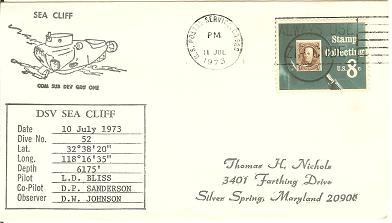 |
United States |
|
US Navy Deep Submergence Vehicle, DSV Sea Cliff, dive no.52 on 10 July 1973, US Postal Service CA, July 11, 1973 |
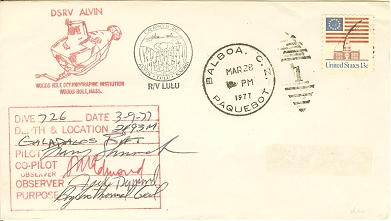 |
United States |
|
US Navy Deep Submergence Rescue Vehicle, DSRV Alvin, dive no.726 on 9 March 1977, Balboa CZ, March 28, 1977 |
 |
Congo, Rep. |
1993 |
Alvin, US Navy Deep Submergence Vehicle (DSV) |
 |
Palau |
1995 |
Alvin 13,500 feet |
 |
Guyana |
1995 |
Submersible Alvin (USA) |
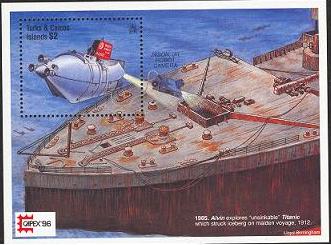 |
Turks and Caicos Is. |
1996 |
1985.Alvin explores "unsinkable" Titanic.Jason Jr. robot camera in margin |
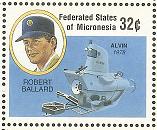 |
Micronesia |
1997 |
Robert Ballard, Alvin 1978 |
 |
United Nations Org. |
1998 |
Submersible, Alvin |
 |
United Nations Org. |
1998 |
Submersible, Alvin |
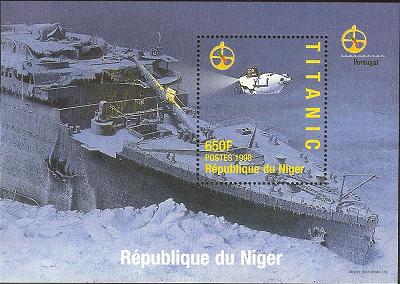 |
Niger |
1998 |
Alvin deep sea submersible inspects sunken Titanic in 1986 (souvenir sheet) |
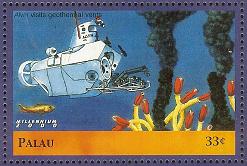 |
Palau |
2000 |
Alvin, 1977 surveys the Galapagos rift |
 |
Antigua & Barbuda |
2000 |
Alvin |
 |
Antigua & Barbuda |
2000 |
Sea Clife |
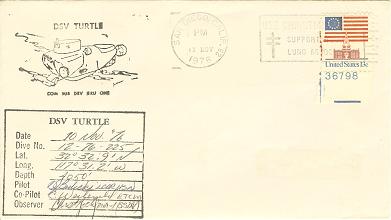 |
United States |
9999 |
US Navy Deep Submergence Vehicle, DSV Turtle, dive no.12-76-225 on 10 Nov` 1976, San Diego CA, Nov` 13, 1976 |
|